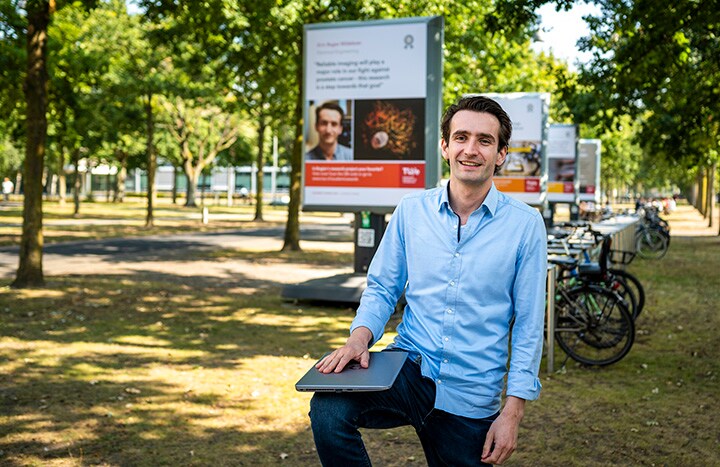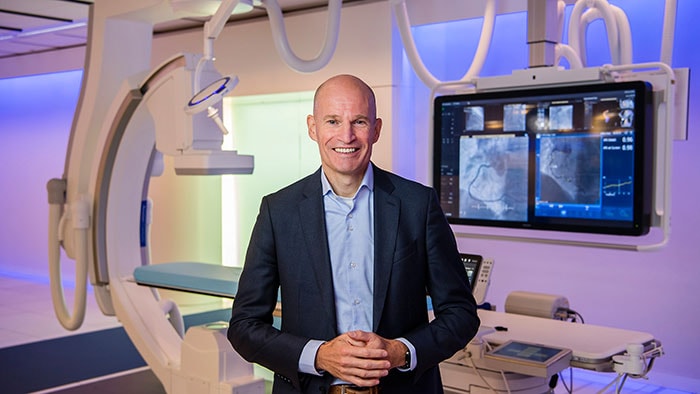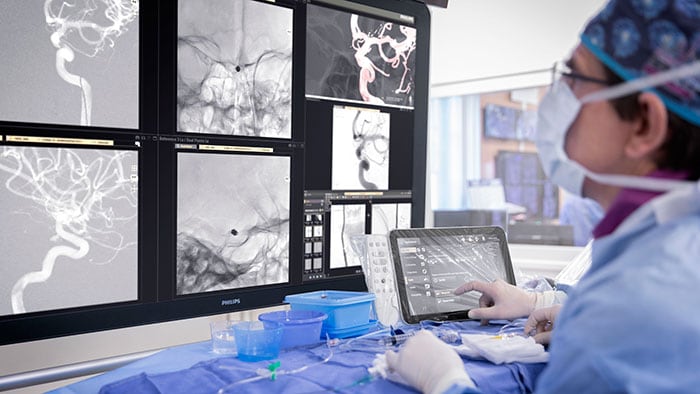Rogier Wildeboer (29) is een bevlogen jonge wetenschapper die gelooft in de kracht van de combinatie. Zijn promotieonderzoek ging over het combineren van verschillende echotechnieken om prostaatkanker op te sporen, met behulp van machine learning. Dat deed hij onder de vlag van e/MTIC - een samenwerking tussen Philips, TU/e en ziekenhuizen in de regio Eindhoven. Bij Philips werkt hij aan innovaties om de techniek voor beeldgestuurde operaties te verbeteren, en krijgt hij de kans om twee passies te combineren: "Als wetenschapper houd ik heel erg van techniek. Maar het is nog veel mooier als je die techniek ook daadwerkelijk kunt toepassen in de klinische praktijk, zodat mensen er iets aan hebben. Techniek zonder toepassing is niks."
Als wetenschapper houd ik heel erg van techniek. Het is mooi als je die techniek ook daadwerkelijk kunt toepassen in de klinische praktijk, zodat mensen er iets aan hebben.
Rogier Wildeboer
Scientist
Je bent zowel fysicus als biomedicus. Zat die brede belangstelling er al vroeg in? "De academische interesse had ik al op de middelbare school, maar ik kon nooit kiezen tussen zowel biologie, scheikunde, natuurkunde en wiskunde. In 5 en 6 VWO mocht ik deelnemen aan een Junior College-programma aan de Universiteit Utrecht waarin alle beta-vakken aan bod kwamen."

Rogier Wildeboer is genomineerd voor de TU/e Academic Awards 2020 voor zijn PhD-proefschrift Hoe kwam je voor je promotieonderzoek bij de TU/e terecht? "Biomedische technologie trok me uiteindelijk het meeste aan, omdat deze studie op het snijvlak zit van natuurkundige techniek en medische wetenschap. Mijn eindonderzoek in Twente ging over het opsporen van uitzaaiingen van borstkanker. Ik twijfelde nog of ik de stap zou maken naar het bedrijfsleven of dat ik eerst wilde promoveren. Toen zag ik een lijst met PhD-opdrachten voorbijkomen, waaronder deze van Philips en TU/e en die trok meteen mijn aandacht." Wat was de essentie van dit onderzoek? "Van prostaatkanker wordt gezegd dat bijna elke man het uiteindelijk krijgt, als hij maar oud genoeg wordt, ook al is de vorm vaak niet direct levensbedreigend; 80 procent van de mannen van 83 hebben de ziekte. Toen ik vijf jaar geleden begon met mijn PhD, moest elke man met verdenking op prostaatkanker nog een vaste biopsie ondergaan en dat kan best pijnlijk zijn. Er worden dan twaalf stukjes weefsel weggehaald om te onderzoeken. De vraag die centraal stond in mijn onderzoek was: kunnen we met behulp van echoscans een deel van de biopsies overbodig maken?"
Toen ik vijf jaar geleden begon met mijn PhD, moest elke man met verdenking op prostaatkanker nog een vaste biopsie ondergaan en dat kan best pijnlijk zijn.
Rogier Wildeboer
Scientist
Om wat voor scans ging het dan? "De afgelopen jaren is er veel onderzoek gedaan naar twee beeldvormende technieken: MRI-scans en echografie. Er is tot nu toe niet één scan die biopsie kan vervangen, maar je komt een heel eind als je verschillende foto's kunt combineren. Dat wordt ook wel multiparametrisch genoemd, omdat je verschillende parameters gebruikt die samen een goed beeld kunnen geven."

"Een van de technieken die ik in mijn onderzoek heb meegenomen is contrastversterkte echo. Mijn promotoren, professor Mischi en professor Wijkstra, hebben hier veel onderzoek naar gedaan. De techniek maakt gebruik van kleine luchtbelletjes die in de bloedbaan worden ingebracht. Luchtbellen kaatsten ontzettend veel geluid terug en daardoor kun je met deze techniek het karakter van bloedvaten in beeld brengen. In kankeronderzoek is dit een waardevolle toepassing, omdat tumoren een bepaalde bloedtoevoer nodig hebben om te kunnen ontwikkelen. Een andere techniek is elastografie, waarbij geluidsgolven worden gebruikt om te kijken hoe elastisch weefsel is. Tumoren zijn vaak stijf. Daarom wordt de techniek wel eens vergeleken met het voelen van een knobbeltje met behulp van geluid." En wat was de toegevoegde waarde van machine learning in je onderzoek? "In het begin van zo'n onderzoek maakte ik gebruik van data uit een kleine patiëntenpopulatie. Toen bleek dat een combinatie van scans inderdaad de potentie had om prostaatkanker beter aan te tonen, werd het van belang om meer data te verzamelen om het model te trainen. Hoe meer input je in machine learning stopt, des te beter het systeem kan leren. Met de hulp van machine learning hebben we nu een model ontwikkeld waarin verschillende parameters, gerelateerd aan bloedvaten of stijfheid van weefsel worden gecombineerd om een beter beeld van tumoren te geven. Dat moet wel nog verder onderzocht worden in de kliniek."
Hoe meer input je in machine learning stopt, des te beter het systeem kan leren. Daardoor hebben we nu een model ontwikkeld om een beter beeld van tumoren te geven.
Rogier Wildeboer
Scientist
Je promotieonderzoek vond plaats onder de vlag van e/MTIC. Wat heeft deze samenwerking tussen Philips, de TU/e en regionale zorginstellingen voor jou als voordeel gehad? "Het is sowieso aantrekkelijk om de combinatie te hebben van wetenschap, bedrijfsleven en klinische praktijk. Ik kan wel zeggen dat e/MTIC mij vooral de vrijheid heeft geboden om samen te werken met verschillende ziekenhuizen, ook buiten de regio. Zo heb ik veel gehad aan de samenwerking met het AMC in Amsterdam, het Jeroen Bosch Ziekenhuis in Den Bosch en zelfs een ziekenhuis in Hamburg. Binnen e/MTIC kon ik vaak weg van mijn bureau en in ziekenhuizen gaan kijken hoe het er in de praktijk aan toegaat."

Na je promotie - die je cum laude hebt afgerond - ben je bij Philips aan de slag gegaan. Lag dat nog steeds voor de hand, na al die jaren? "Philips was voor mij zeker nog een logische keuze. Ik werk nu aan innovaties op het gebied van hartkatheters. Voor operaties wordt röntgen gebruikt om het lichaam en bijvoorbeeld bloedvaten goed te bekijken en ook de devices in het lichaam te navigeren. Röntgen is echter schadelijk voor de patiënt en vooral ook voor het operatiepersoneel. We werken daarom aan innovaties om de blootstelling aan straling te verminderen door alternatieve manieren te bedenken waarop een arts in het lichaam van de patiënt kan kijken tijdens de operatie. Cardiologen die een hartinterventie uitvoeren met behulp van katheters kunnen zo zien wat aan het doen zijn; een mooi voorbeeld van zo’n innovatie is de KODEX-EPD oplossing van Philips."
We werken aan innovaties om de blootstelling aan straling te verminderen door alternatieve manieren te bedenken waarop een arts in het lichaam van de patiënt kan kijken tijdens de operatie.
Rogier Wildeboer
Scientist
Hoe is het om als wetenschapper in het bedrijfsleven te werken? "Ik heb het enorm naar mijn zin gehad op de universiteit. Maar ik werd ook juist heel nieuwsgierig naar hoe het er in het bedrijfsleven aan toe gaat. Ik merk vooral dat je iets praktischer te werk gaat. In academisch onderzoek wil je vooral alles goed uitzoeken, of iets werkt of niet en waarom dan. Bij Philips werk je echt toe naar de toepassing in de praktijk. Als wetenschapper houd ik heel erg van techniek. Maar het is nog veel mooier als je die techniek ook daadwerkelijk kunt toepassen in de klinische praktijk, zodat mensen er iets aan hebben. Techniek zonder toepassing is niks." Elke dag proberen we manieren te vinden om het leven te verbeteren, soms in kleine stapjes, soms met grote sprongen. Binnen Philips werken veel talenten aan technologische innovaties op het gebied van zorg en gezondheid. In de serie Young Innovators komen deze vernieuwers aan het woord en vertellen ze waar ze aan werken, wat hen motiveert en wat hun ambities zijn voor de toekomst. Lees ook dit eerdere artikel: 'Ik wil gewoon heel graag bijdragen aan innovatieve oplossingen voor de zorg', een interview met Eline van Haaften, die op haar 27e cum laude afstudeerde en verschillende onderscheidingen kreeg. ‘De jongen die wolf riep’; Rohan Joshi (30) promoveerde op alarmmoeheid op de IC. Bij Philips werkt hij aan innovaties om te vroeg geboren baby's te monitoren.
e/MTIC
Philips maakt deel uit van het samenwerkingsverband e/MTIC (Eindhoven MedTech Innovation Center) dat bestaat uit de Technische Universiteit Eindhoven, Philips, Máxima Medisch Centrum, Catharina Ziekenhuis en Kempenhaeghe Expertisecentrum. Snelle implementatie van hightech innovaties in de gezondheidszorg is van belang om een kosteneffectief zorgsysteem in stand te houden. Hierbij is het van belang dat de focus ligt op wat individuele patiënten werkelijk nodig hebben voor betere gezondheidszorg. De missie van e/MTIC is om value based gezondheidszorg te stimuleren door een ecosysteem te creëren dat onderzoek, ontwikkeling en implementatie van duurzame innovaties in de klinische praktijk versnelt door de geïnstitutionaliseerde samenwerking tussen regionale partners te versterken die zich richten op onderzoek en innovatie in vooraf gedefinieerde klinische domeinen. Meer info op: https://www.tue.nl/en/research/research-groups/eindhoven-medtech-innovation-center/

‘As a scientist I like technology, but technology without application is nothing'
Rogier Wildeboer (29) is an enthusiastic young scientist who believes in the power of combination. His PhD research was about combining different ultrasound techniques to detect prostate cancer, using machine learning. He did this under the banner of e/MTIC - a collaboration between PhiFor lips, TU/e and hospitals in the Eindhoven region. At Philips, he's working on innovations to improve the technique for image-based surgery, and he gets the chance to combine two passions: "As a scientist, I love technology very much. But it's even better if you can actually apply that technology in clinical practice, so that people can benefit from it. Technology without application is nothing.
As a scientist, I love technology very much. It is great if you can actually apply that technology in clinical practice, so that people can benefit from it.
Rogier Wildeboer
Scientist
You are both a physicist and a biomedicine practitioner. Was this broad interest in you at an early stage? "I had the academic interest in high school, but I could never choose between biology, chemistry, physics and mathematics. In 5 and 6 VWO I was allowed to take part in a Junior College programme at Utrecht University in which all the beta subjects were covered".

Rogier Wildeboer is nominated for the TU/e Academic Awards 2020 for his PhD thesis How did you end up at TU/e for your PhD research? "Biomedical technology ultimately attracted me the most, because this study is at the intersection of physics engineering and medical science. My final study in Twente was about detecting metastases of breast cancer. I was still in doubt as to whether I would make the move to industry or whether I wanted to obtain a PhD first. Then I saw a list of PhD assignments passing by, including those from Philips and TU/e, and it immediately caught my interest". What was the essence of this research? "Prostate cancer is said to affect almost every man, as long as he gets old enough, even if the form is often not directly life-threatening; 80% of men aged 83 have the disease. When I started my PhD five years ago, every man suspected of developing prostate cancer had to undergo a solid biopsy, and that can be quite painful. Twelve pieces of tissue are then removed for examination. The question that was central to my research was: can we use ultrasound scans to make some of the biopsies unnecessary?
When I started my PhD five years ago, every man suspected of developing prostate cancer had to undergo a solid biopsy, and that can be quite painful.
Rogier Wildeboer
Scientist
What kind of scans were they? "In recent years a lot of research has been done into two imaging techniques: MRI scans and ultrasound. So far there is not a single scan that can replace biopsy, but you can go a long way if you can combine different images. This is also known as multiparametric, because you use different parameters that together can give a good picture."

"One of the techniques I have included in my research is contrast-enhanced echo. My supervisors, Professor Mischi and Professor Wijkstra, have done a lot of research into this. The technique uses small air bubbles that are introduced into the bloodstream. Air bubbles bounced back an awful lot of sound and this technique allows you to visualise the character of blood vessels. This is a valuable application in cancer research because tumours need a certain blood supply in order to develop. Another technique is elastography, in which sound waves are used to see how elastic tissue is. Tumours are often stiff. This is why the technique is sometimes compared to feeling a lump using sound". What was the added value of machine learning in your research? "At the beginning of such a study, I used data from a small patient population. When it appeared that a combination of scans indeed had the potential to better demonstrate prostate cancer, it became important to collect more data to train the model. The more input you put into machine learning, the better the system can learn. With the help of machine learning, we have now developed a model that combines different parameters related to blood vessels or stiffness of tissue to provide a better picture of tumours. However, this needs to be further investigated in the clinic."
The more input you put into machine learning, the better the system can learn. That is why we have now developed a model to provide a better picture of tumours.
Rogier Wildeboer
Scientist
Your PhD research took place under the banner of e/MTIC. What has this collaboration between Philips, the TU/e and regional healthcare institutions done for you? "It is attractive to have the combination of science, industry and clinical practice. e/MTIC has mainly given me the freedom to work with different hospitals, including those outside the region. For example, I have benefited a lot from working with the AMC in Amsterdam, the Jeroen Bosch Hospital in Den Bosch and even a hospital in Hamburg. Within e/MTIC I was often able to get away from my desk and go to hospitals to see how things are going in practice".

After your promotion - which you completed cum laude - you started working at Philips. Was that still obvious, after all these years? "Philips was certainly still a logical choice for me. I am now working on innovations in the field of cardiac catheters. For operations, X-rays are used to take a good look at the body and blood vessels, for example, and also to navigate the devices inside the body. However, X-rays are harmful to the patient and, above all, to the surgical staff. We are therefore working on innovations to reduce exposure to radiation by devising alternative ways for a doctor to look inside the patient's body during surgery. Cardiologists performing cardiac interventions using catheters can see what they are doing; a good example of such an innovation is Philips' KODEX-EPD solution".
We are working on innovations to reduce exposure to radiation by devising alternative ways for a doctor to look inside the patient's body during surgery.
Rogier Wildeboer
Scientist
What is it like to work as a scientist in business? "I had a great time at university. But I also became very curious about how things were going in the business world. Above all, I noticed that you work in a more practical way. In academic research you mainly want to find out whether something works or not and why. At Philips you really work towards the application in practice. As a scientist I really like technology. But it's even better if you can actually apply that technique in clinical practice, so that people can benefit from it. Technology without application is nothing." Every day we are looking for ways to improve life - sometimes in small steps, sometimes in big leaps. Within Philips, many talents are working on technological innovations for care and health. In the Young Innovators series, these innovators have their say; what are they working on? What drives them? What are their ambitions for the future? Also check out these previous episodes: 'I just really want to contribute to innovative solutions for care'; an interview with Eline van Haaften, who graduated cum laude when she was 27 and received several awards (Dutch) 'The boy who cried wolf'; Rohan Joshi (30) was promoted on alarm fatigue in the IC. At Philips, he is working on innovations to monitor premature babies.
e/MTIC
Philips is part of the e/MTIC (Eindhoven MedTech Innovation Center) partnership between Eindhoven University of Technology, Philips, Máxima Medical Center, Catharina Hospital and Kempenhaeghe Expertise Center. Fast implementation of dedicated high-tech health care innovations will be indispensable to maintain a cost-effective healthcare system that is configured around what individual patients really need for a better health care outcome. The mission of e/MTIC is to drive value-based healthcare by growing an ecosystem that creates a fast-track in research, development and implementation of sustainable innovations in clinical practice by strengthening the institutionalized collaboration between regional partners focusing on research and innovation in pre-defined clinical domains. More information on: https://www.tue.nl/en/research/research-groups/eindhoven-medtech-innovation-center/
Deel op social media
Onderwerpen
Contact

Tommie Dijstelbloem
Woordvoerder Philips Benelux Tel: +31 6 19 28 83 20
You are about to visit a Philips global content page
Continue












